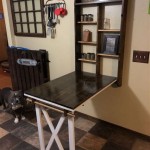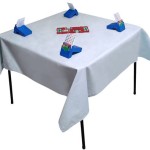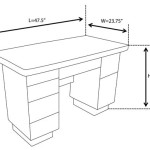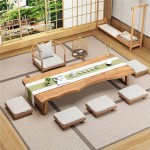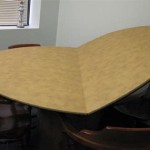Types of Plastic Study Tables: A Comprehensive Overview
Plastic study tables have become increasingly popular in homes, schools, and libraries due to their affordability, durability, and versatility. Understanding the different types available is crucial for making an informed decision that aligns with specific needs and preferences. This article aims to provide a comprehensive overview of various plastic study tables, categorizing them by material, design, and functionality, highlighting their respective advantages and disadvantages.
The material composition of a plastic study table significantly influences its strength, weight, and resistance to environmental factors. Different types of plastics are employed in their construction, each possessing distinct characteristics. Furthermore, the design elements such as shape, size, and storage options play a vital role in determining the suitability of a particular table for different users and environments. Finally, functionality, encompassing features such as adjustability and portability, further differentiates the diverse range of plastic study tables available.
Plastic Materials Used in Study Table Construction
The choice of plastic material is paramount in determining the overall quality and performance of a study table. Common types of plastics used include polypropylene (PP), polyethylene (PE), acrylonitrile butadiene styrene (ABS), and high-density polyethylene (HDPE). Each material exhibits unique properties that affect the durability, weight, and appearance of the finished product.
Polypropylene (PP) is a versatile thermoplastic polymer known for its high strength-to-weight ratio and excellent chemical resistance. PP study tables are generally lightweight yet sturdy, making them suitable for both indoor and outdoor use. They are resistant to moisture, making them easy to clean and maintain. However, PP can be susceptible to UV degradation, so prolonged exposure to direct sunlight may cause it to become brittle and discolored over time.
Polyethylene (PE) is another widely used thermoplastic polymer, available in various densities. Low-density polyethylene (LDPE) is flexible and impact-resistant, making it suitable for less demanding applications. High-density polyethylene (HDPE), on the other hand, is significantly stronger and more rigid than LDPE. HDPE study tables are highly durable and resistant to cracking and warping. They are often used in environments where heavy use and rough handling are expected. Like PP, PE is also susceptible to UV degradation, although some manufacturers incorporate UV stabilizers to improve its resistance.
Acrylonitrile Butadiene Styrene (ABS) is a strong and rigid thermoplastic polymer known for its excellent impact resistance and dimensional stability. ABS study tables are often more visually appealing than those made from PP or PE, as ABS can be easily molded into intricate shapes and finished with a smooth, glossy surface. ABS is also resistant to a wide range of chemicals, making it easy to clean and maintain. However, ABS is generally more expensive than PP or PE, and it can be susceptible to scratching and discoloration over time.
In addition to these common plastics, some manufacturers may use other materials such as polycarbonate (PC) or acrylic (PMMA) for specific components or features of a study table. These materials offer enhanced properties such as high transparency and impact resistance, but they are typically more expensive than PP, PE, or ABS.
Design Variations in Plastic Study Tables
Beyond the material composition, the design of a plastic study table significantly impacts its functionality and suitability for various environments. Design considerations include the table's shape, size, storage options, and overall aesthetic appeal. Manufacturers offer a wide range of design variations to cater to diverse needs and preferences.
Rectangular study tables are the most common type, offering a traditional and versatile design that is suitable for a wide range of tasks. They provide ample workspace for spreading out books, papers, and other materials. Rectangular tables are available in various sizes, from small individual desks to large collaborative workstations. Some rectangular tables may feature rounded corners to enhance safety, particularly in environments where children are present.
Folding study tables are designed for portability and space-saving storage. They typically feature a collapsible frame and a lightweight plastic tabletop. Folding tables are ideal for temporary workspaces or situations where space is limited. They can be easily folded up and stored away when not in use. However, folding tables may not be as sturdy as fixed-frame tables, and they may not be suitable for heavy-duty tasks.
Height-adjustable study tables allow users to customize the table's height to their preferred ergonomic position. This is particularly important for children and teenagers who are still growing, as it allows them to maintain proper posture and reduce the risk of musculoskeletal problems. Height-adjustable tables may feature manual or electric adjustment mechanisms. Some models also include features such as tiltable tabletops and integrated book stands.
Study tables with built-in storage options are designed to maximize space and organization. These tables may feature drawers, shelves, or compartments for storing books, stationery, and other supplies. Storage options can be particularly useful for students who need to keep their workspace tidy and organized. The type and configuration of storage options will vary depending on the specific design of the table.
Corner study tables are designed to fit snugly into corners, maximizing space utilization in small rooms. They typically feature a triangular or L-shaped tabletop that provides ample workspace while minimizing the table's footprint. Corner tables are ideal for students who need a dedicated workspace but have limited space available.
In addition to these common designs, manufacturers also offer specialized study tables with unique features and functionalities. For example, some tables may feature integrated cable management systems to keep cords and cables organized. Others may include built-in LED lighting to provide adequate illumination for studying. The availability of specialized designs is constantly evolving as manufacturers strive to meet the changing needs of students and educators.
Functionality and Features of Plastic Study Tables
The functionality of a plastic study table extends beyond its basic design and material composition. Features such as adjustability, portability, weight capacity, and ease of cleaning contribute significantly to its overall usability and suitability for specific applications. Careful consideration of these functional aspects is essential when selecting a study table.
Adjustability, as previously mentioned, is a key functional feature, particularly for tables designed for children and teenagers. Height-adjustable tables allow users to customize the table's height to their individual needs, promoting good posture and reducing strain. Additionally, some tables may feature adjustable tabletop angles, allowing users to optimize the surface for reading, writing, or drawing.
Portability is an important consideration for users who need to move the table frequently. Folding study tables are inherently portable, but even fixed-frame tables can be designed with lightweight materials and features such as carrying handles or wheels to enhance their portability. Portability is particularly important for temporary workspaces or shared learning environments.
Weight capacity refers to the maximum weight that the table can safely support. It is crucial to select a table with a weight capacity that is adequate for the intended use. Overloading a table can lead to structural damage and potential safety hazards. The weight capacity of a plastic study table is typically determined by the material and design of its frame and tabletop.
Ease of cleaning is a significant advantage of plastic study tables. Most plastics are resistant to moisture and stains, making them easy to wipe clean with a damp cloth or sponge. This is particularly important in environments where spills and messes are common, such as classrooms and children's rooms. Some plastics may require special cleaning solutions to remove stubborn stains, but generally, plastic study tables are very low-maintenance.
Durability is a crucial functional aspect that is directly related to the material and construction of the table. A durable study table will withstand years of use and resist damage from impacts, scratches, and exposure to the elements. Selecting a table made from high-quality plastic and featuring a sturdy frame is essential for ensuring long-term durability.
Finally, the overall aesthetic appeal of a study table can also contribute to its functionality. A well-designed and visually appealing table can create a more inviting and productive workspace. Plastic study tables are available in a wide range of colors, styles, and finishes to complement any décor. Choosing a table that is both functional and aesthetically pleasing can enhance the learning environment and promote a positive attitude towards studying.

Office Study Table Buy At Best S In Flipkart Com

Wonder Plastic Table At Rs 615 Tables In Bhiwandi Id 23187061348

Study Tables For Bed 8 Best That Will Enhance Your Ivity 2024 The Economic Times

Four Types Of Study Tables To Clear Furniture Home Living Sets On Carou

Plastic Folding Table At Rs 2000 Piece Foldable In Pune Id 12966135873

Elevate Your Classroom Aesthetics With Vibrant Kids Plastic Furniture

Up To 70 Off On Study Tables Summer Urban Ladder

Study Table Designs For Two Students A List Of Amazing

Study Tables Buy Upto 60 Off Pepperfry

Study Tables For Bed 8 Best That Will Enhance Your Ivity 2024 The Economic Times


